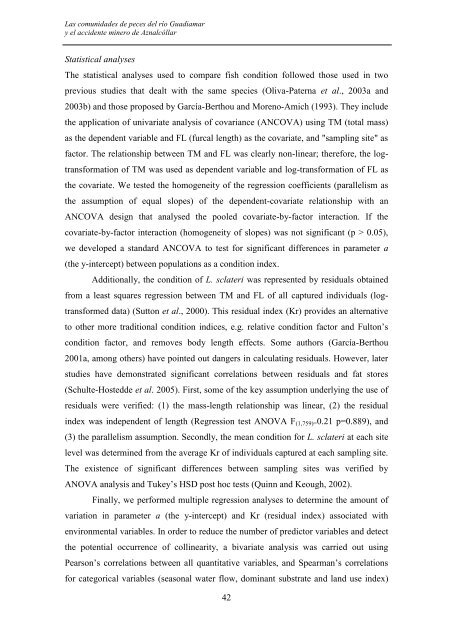las comunidades de peces del río guadiamar y el accidente minero ...
las comunidades de peces del río guadiamar y el accidente minero ...
las comunidades de peces del río guadiamar y el accidente minero ...
You also want an ePaper? Increase the reach of your titles
YUMPU automatically turns print PDFs into web optimized ePapers that Google loves.
Las <strong>comunida<strong>de</strong>s</strong> <strong>de</strong> <strong>peces</strong> <strong>de</strong>l <strong>río</strong> Guadiamar<br />
y <strong>el</strong> acci<strong>de</strong>nte <strong>minero</strong> <strong>de</strong> Aznalcóllar<br />
Statistical analyses<br />
The statistical analyses used to compare fish condition followed those used in two<br />
previous studies that <strong>de</strong>alt with the same species (Oliva-Paterna et al., 2003a and<br />
2003b) and those proposed by García-Berthou and Moreno-Amich (1993). They inclu<strong>de</strong><br />
the application of univariate analysis of covariance (ANCOVA) using TM (total mass)<br />
as the <strong>de</strong>pen<strong>de</strong>nt variable and FL (furcal length) as the covariate, and "sampling site" as<br />
factor. The r<strong>el</strong>ationship between TM and FL was clearly non-linear; therefore, the logtransformation<br />
of TM was used as <strong>de</strong>pen<strong>de</strong>nt variable and log-transformation of FL as<br />
the covariate. We tested the homogeneity of the regression coefficients (parall<strong>el</strong>ism as<br />
the assumption of equal slopes) of the <strong>de</strong>pen<strong>de</strong>nt-covariate r<strong>el</strong>ationship with an<br />
ANCOVA <strong>de</strong>sign that analysed the pooled covariate-by-factor interaction. If the<br />
covariate-by-factor interaction (homogeneity of slopes) was not significant (p > 0.05),<br />
we <strong>de</strong>v<strong>el</strong>oped a standard ANCOVA to test for significant differences in parameter a<br />
(the y-intercept) between populations as a condition in<strong>de</strong>x.<br />
Additionally, the condition of L. sclateri was represented by residuals obtained<br />
from a least squares regression between TM and FL of all captured individuals (logtransformed<br />
data) (Sutton et al., 2000). This residual in<strong>de</strong>x (Kr) provi<strong>de</strong>s an alternative<br />
to other more traditional condition indices, e.g. r<strong>el</strong>ative condition factor and Fulton’s<br />
condition factor, and removes body length effects. Some authors (García-Berthou<br />
2001a, among others) have pointed out dangers in calculating residuals. However, later<br />
studies have <strong>de</strong>monstrated significant corr<strong>el</strong>ations between residuals and fat stores<br />
(Schulte-Hosted<strong>de</strong> et al. 2005). First, some of the key assumption un<strong>de</strong>rlying the use of<br />
residuals were verified: (1) the mass-length r<strong>el</strong>ationship was linear, (2) the residual<br />
in<strong>de</strong>x was in<strong>de</strong>pen<strong>de</strong>nt of length (Regression test ANOVA F (1,759)= 0.21 p=0.889), and<br />
(3) the parall<strong>el</strong>ism assumption. Secondly, the mean condition for L. sclateri at each site<br />
lev<strong>el</strong> was <strong>de</strong>termined from the average Kr of individuals captured at each sampling site.<br />
The existence of significant differences between sampling sites was verified by<br />
ANOVA analysis and Tukey’s HSD post hoc tests (Quinn and Keough, 2002).<br />
Finally, we performed multiple regression analyses to <strong>de</strong>termine the amount of<br />
variation in parameter a (the y-intercept) and Kr (residual in<strong>de</strong>x) associated with<br />
environmental variables. In or<strong>de</strong>r to reduce the number of predictor variables and <strong>de</strong>tect<br />
the potential occurrence of collinearity, a bivariate analysis was carried out using<br />
Pearson’s corr<strong>el</strong>ations between all quantitative variables, and Spearman’s corr<strong>el</strong>ations<br />
for categorical variables (seasonal water flow, dominant substrate and land use in<strong>de</strong>x)<br />
42

















